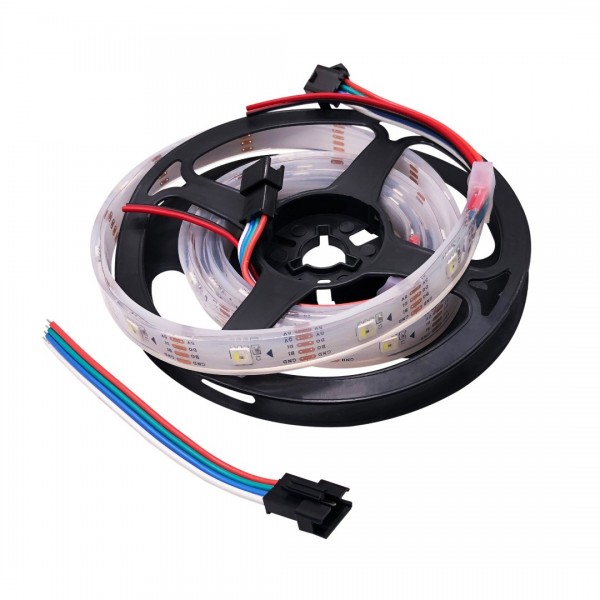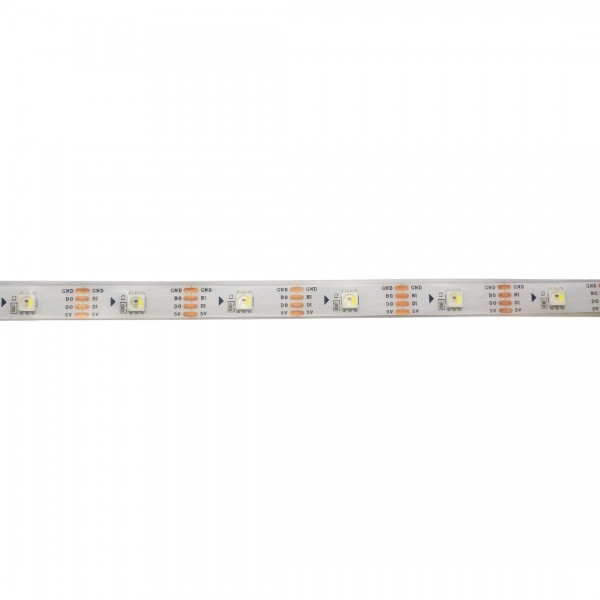WorldSemi WS2813 Digital 5050 RGBW LED Strip - IP68 - 30 LEDs 1m
- Availability: Directly available from warehouse in Eindhoven
- SKU: 004639
€12.50
Ex Tax: €10.33
Your shopping cart is empty!






A digital LED strip of which the color and brightness of each LED can be controlled separately. A lot of LEDs can be placed in sequence and all can be controlled with 1 pin of a microcontroller. Various platforms provide support for this LED by means of libraries, including Arduino and Raspberry Pi.
This LED strip has a water-resistant layer so that the strip can be used outdoors, for example. Please note, due to the water-resistant layer, the LED strip cannot be shortened. In addition, the layer has an insulating effect. As a result the LEDs dissipate their heat less well. We therefore advise against using the LED strip at maximum power continuously in order to extend the lifetime.
This LED strip also has a backup data line. If one LED fails, this backup line ensures that the remaining LEDs continue to work. Only if you have two defective LEDs in a row, the rest of the LEDs will stop working, but that chance is small.
Connecting the strip:
*There are many power supplies on the market that have a China Export ("fake" CE marking) or carry a CE marking, but are in reality not CE approved. We do not recommend using these, often cheap (Chinese), power supplies because they generally do not provide a stable voltage. A stable voltage is essential to make the LEDS work stable, and to prevent damaging them.
We recommend reading the following pages for more information (especially when using multiple LED strips): Powering Neopixels and Adafruit NeoPixel Überguide.
Check the tab "Downloads" for more information and/or downloads.
This product has 0 review(s) in total.
Datasheet: 004639_Data-Sheet-of-WS2813B-RGBW-LED.pdf
| General | |
| Brand | WorldSemi |
| Norm conformity | RoHS |
| General physical appearance | |
| Main color | White |
| Weight [g] | 76 |
| Dimension X [mm] | 1000 |
| Dimension Y [mm] | 12 |
| Dimension Z [mm] | 4 |
| Water and dust protection | IP68 |
| Form factor | Strip |
| General electrical properties | |
| Minimum supply voltage [V DC] | 5 |
| Maximum supply voltage [V DC] | 5 |
| Minimum recommended supply current [A] | 2.0 |
| Minimum IO-pin input voltage [V] | 5 |
| Maximum IO-pin input voltage [V] | 5 |
| Communication | |
| Hardware interface(s) | Digital |
| Back-up data line | Yes |
| LED | |
| LED (driver) chip | WS2813B-RGBW |
| LED color | RGB+W |
| Number of LEDs | 30 |
| Maximum current per LED [mA] | 60 ±10% |
| Connectors | |
| Power supply connector(s) | JST-SM (compatible) male JST-SM (compatible) female Loose wire |
| IO-connector(s) | JST-SM (compatible) male JST-SM (compatible) female |
| Package contents | |
| Package contents | 1x LED strip 1x JST-SM connector cable |
Use a stable, CE-approved power supply with the correct voltage that can supply sufficient current. The maximum current that an LED can draw is indicated on the product page. Multiply this number by the number of LEDs to calculate the total maximum current. This maximum current is the minimum current that the power supply must be able to supply.
Supplies:
The following components are required to operate a product with digital LEDs:
The following parts are optional:
Connecting the strip:
*There are many power supplies on the market that have a China Export ("fake" CE marking) or carry a CE marking, but are in reality not CE approved. We do not recommend using these, often cheap (Chinese), power supplies because they generally do not provide a stable voltage. A stable voltage is essential to make the LEDS work stable, and to prevent damaging them.
More information:
We recommend reading the following pages for more information (especially when using multiple LED strips): Powering Neopixels and Adafruit NeoPixel Überguide.
This can have several causes. The most common causes are:
Signal voltage too low
For example, WS2812B LEDs have a signal voltage of 5V. When these are controlled with a voltage of 3.3V (as with ESP32/ESP8266/Raspberry Pi), data may not be properly received at one or more LEDs, resulting in the wrong color. This can be solved by increasing the signal voltage to 5V using a level converter.
Noise on the signal pin
The signal pin is sensitive to noise. This can be solved by connecting a 470Ω resistor in series between the microcontroller and the signal pin of the LEDs.
Voltage drop in supply voltage
Particularly with many LEDs in succession, it can happen that a part does not display the right color. This may be a sign that the supply voltage has dropped too far due to losses in the cabling. This can be solved by using extra thick power cables and connecting them between each strip.